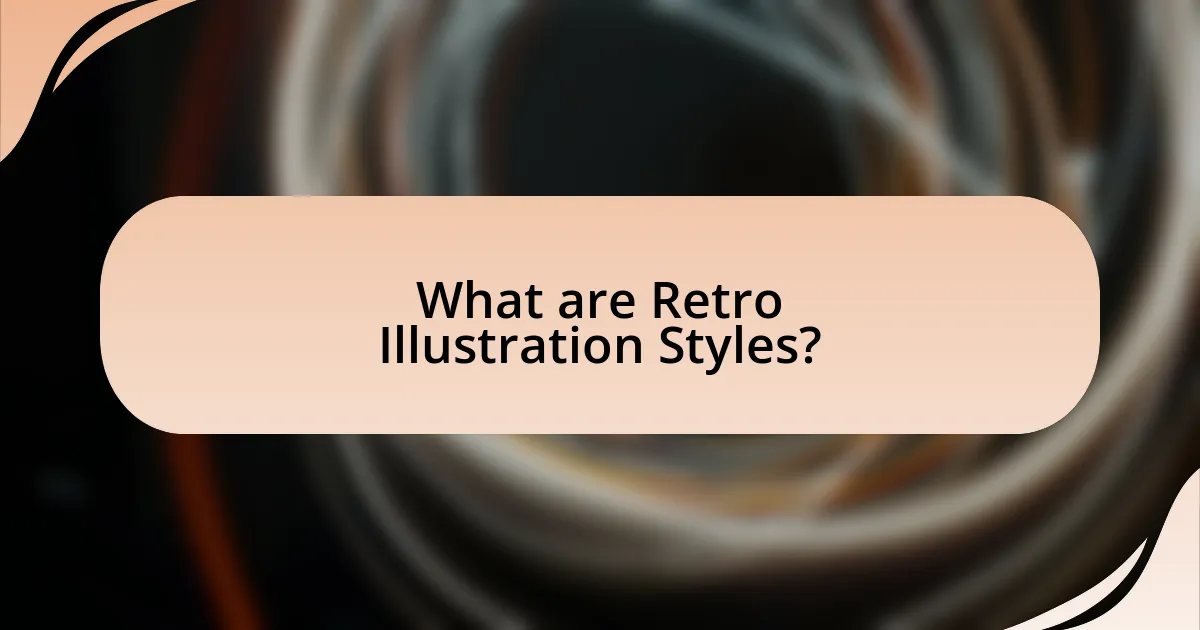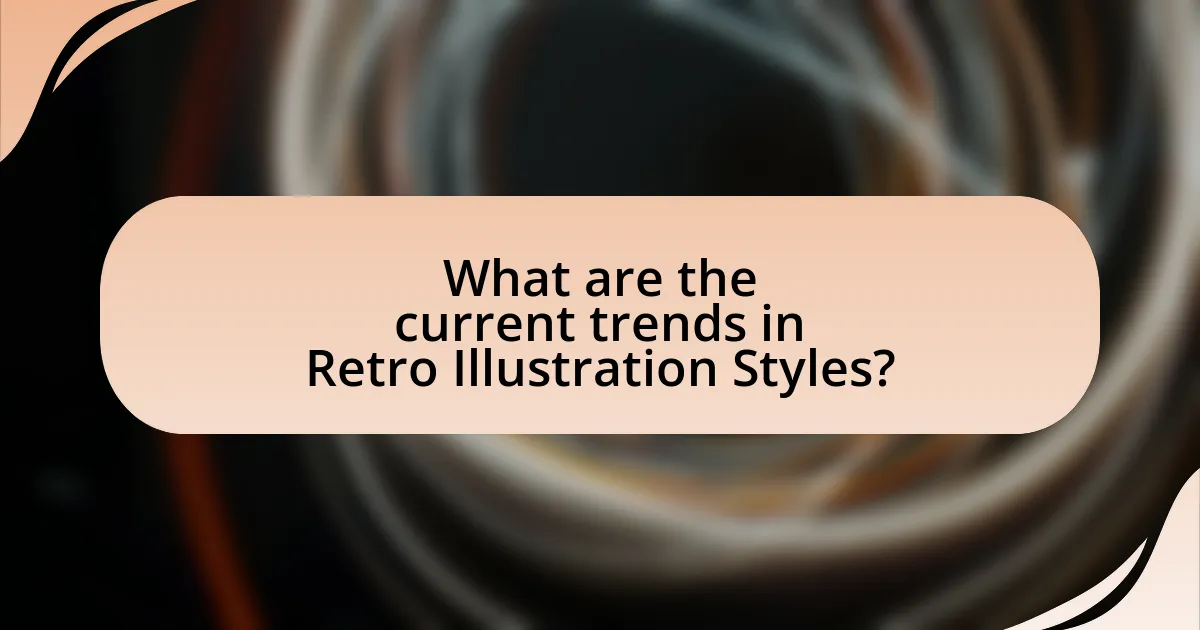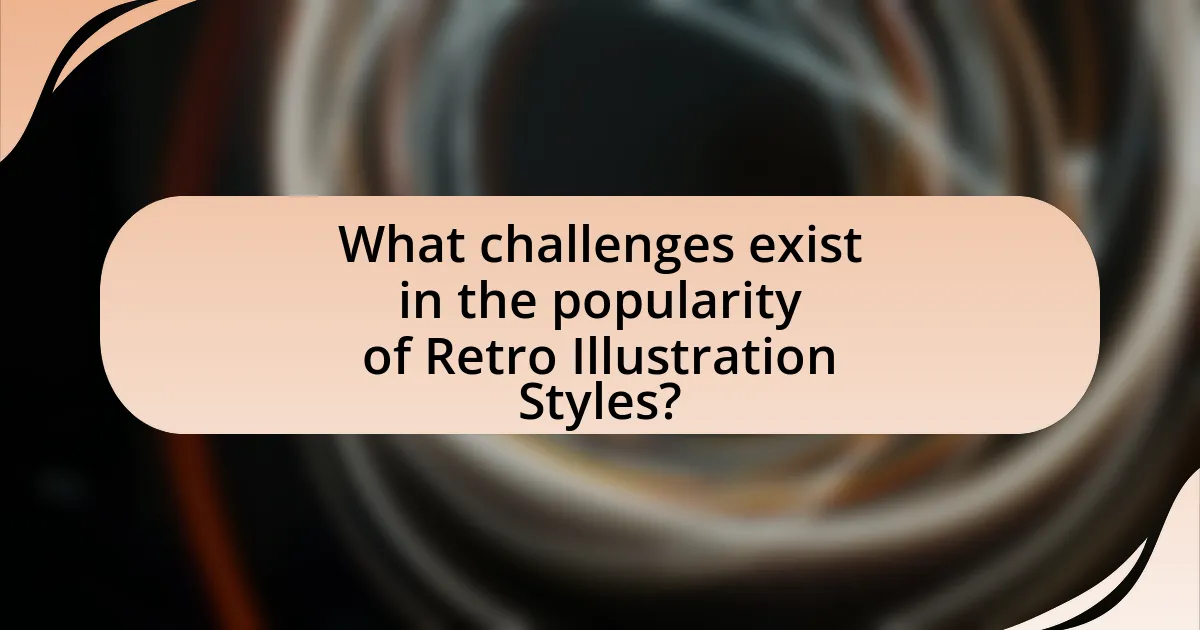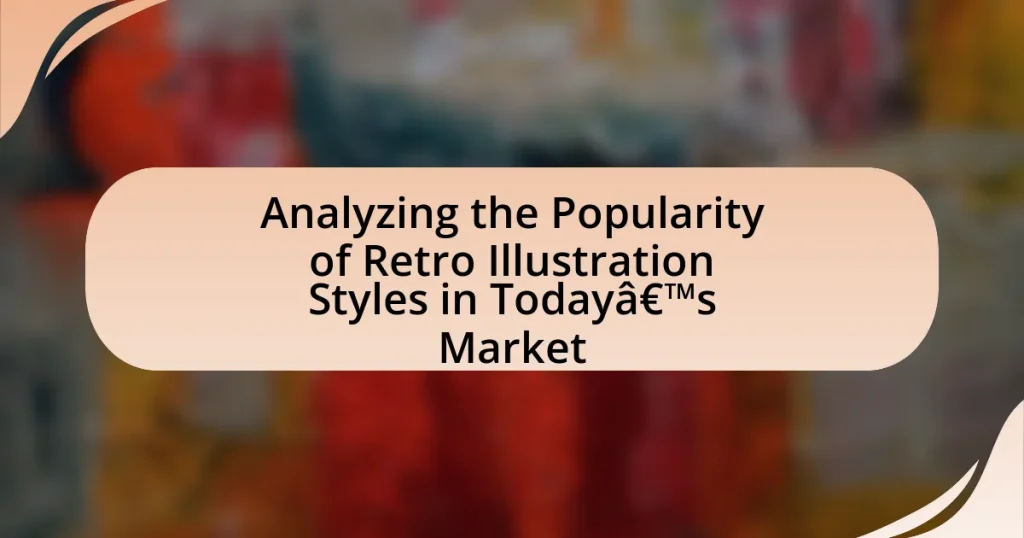Retro illustration styles are artistic approaches that draw inspiration from mid-20th century design trends, characterized by bold colors, geometric shapes, and nostalgic themes. This article analyzes the evolution of these styles, influenced by historical movements such as Art Deco and Mid-Century Modern, and examines their resurgence in contemporary design due to technological advancements and cultural factors. It highlights the significance of retro illustrations in various industries, including advertising and fashion, and discusses current trends, challenges, and best practices for designers. The article also explores how brands leverage nostalgia to enhance consumer engagement and create cohesive brand identities.

What are Retro Illustration Styles?
Retro illustration styles are artistic approaches that draw inspiration from design trends and aesthetics of past decades, particularly from the mid-20th century. These styles often feature bold colors, geometric shapes, and nostalgic themes, reflecting the visual language of the 1950s to 1980s. The resurgence of retro illustration styles in contemporary design can be attributed to their ability to evoke nostalgia and connect with audiences on an emotional level, making them popular in various media, including advertising, branding, and digital art.
How did Retro Illustration Styles evolve over time?
Retro illustration styles evolved through distinct phases influenced by cultural, technological, and artistic trends. Initially, in the early 20th century, retro illustrations were characterized by Art Deco and Art Nouveau movements, which emphasized ornate designs and elegant lines. As the mid-20th century approached, the rise of advertising and consumer culture led to the popularity of bold colors and simplified forms, seen in the works of artists like Saul Bass and the use of flat design in print media.
The 1960s and 1970s introduced psychedelic art and counterculture influences, which further transformed retro styles into vibrant, surreal visuals. The advent of digital technology in the late 20th century allowed for the revival and reinterpretation of these styles, making them accessible to a broader audience. Today, retro illustration styles are often blended with modern aesthetics, reflecting nostalgia while incorporating contemporary design principles. This evolution is evident in the resurgence of vintage-inspired branding and packaging, which appeals to consumers’ desire for authenticity and connection to the past.
What historical movements influenced Retro Illustration Styles?
Retro illustration styles have been significantly influenced by several historical movements, including Art Deco, Bauhaus, and the Mid-Century Modern movement. Art Deco, which emerged in the 1920s, emphasized geometric shapes and bold colors, shaping the visual language of retro illustrations. The Bauhaus movement, active from 1919 to 1933, introduced a focus on simplicity and functionality, which can be seen in the clean lines and minimalistic designs of retro styles. Additionally, the Mid-Century Modern movement, prevalent from the 1940s to the 1960s, celebrated organic forms and vibrant colors, further contributing to the aesthetic of retro illustrations. These movements collectively established a foundation that continues to resonate in contemporary design, making retro styles appealing in today’s market.
How have technological advancements impacted Retro Illustration Styles?
Technological advancements have significantly transformed Retro Illustration Styles by enhancing accessibility and enabling new creative techniques. Digital tools such as graphic design software and tablets allow artists to replicate traditional styles with greater precision and efficiency, making it easier to produce high-quality retro illustrations. For instance, software like Adobe Illustrator and Procreate provides features that mimic traditional media, allowing artists to create vintage aesthetics while benefiting from modern conveniences. Additionally, the rise of social media platforms has facilitated the sharing and promotion of retro illustrations, increasing their visibility and popularity in contemporary markets. This combination of improved tools and wider distribution channels has led to a resurgence of interest in retro styles, as artists can now reach broader audiences and engage with communities that appreciate nostalgic aesthetics.
Why are Retro Illustration Styles significant in today’s market?
Retro illustration styles are significant in today’s market because they evoke nostalgia and connect consumers with past cultural aesthetics. This emotional resonance drives engagement, as brands leverage retro designs to create a sense of familiarity and authenticity. For instance, a study by the Journal of Consumer Research found that nostalgic branding can enhance consumer loyalty and increase purchase intentions by up to 20%. Additionally, the rise of digital platforms allows for the widespread sharing of retro-inspired content, further amplifying its appeal and relevance in contemporary design trends.
What cultural factors contribute to the resurgence of Retro Illustration Styles?
The resurgence of Retro Illustration Styles is primarily driven by nostalgia, as contemporary audiences seek connections to past aesthetics and cultural references. This longing for simpler times is reflected in various media, including fashion, music, and graphic design, where retro elements evoke emotional responses and familiarity. Additionally, the rise of social media platforms allows for the rapid sharing and appreciation of vintage styles, creating a community that celebrates and promotes these artistic expressions. The blending of modern technology with traditional techniques also enhances the appeal, as artists can recreate retro styles while reaching wider audiences. This combination of nostalgia, community engagement, and technological integration solidifies the cultural factors contributing to the popularity of Retro Illustration Styles today.
How do Retro Illustration Styles resonate with contemporary audiences?
Retro illustration styles resonate with contemporary audiences by evoking nostalgia and a sense of authenticity. These styles often draw from the aesthetics of past decades, such as the vibrant colors and playful designs of the 1960s and 1970s, which appeal to consumers seeking a connection to simpler times. Research indicates that nostalgia can enhance emotional well-being and increase consumer engagement, as seen in a study published in the Journal of Consumer Research, which found that nostalgic imagery can positively influence purchasing decisions. Additionally, the rise of social media platforms has facilitated the sharing of retro-inspired content, further amplifying its appeal among younger demographics who appreciate vintage aesthetics. This combination of emotional resonance and visual appeal solidifies the popularity of retro illustration styles in today’s market.

What are the current trends in Retro Illustration Styles?
Current trends in retro illustration styles include a resurgence of 70s and 80s aesthetics, characterized by bold colors, geometric shapes, and a nostalgic feel. This trend is evident in various media, including advertising, packaging, and digital art, where artists are increasingly drawing inspiration from vintage design elements. The popularity of platforms like Instagram and Pinterest has further fueled this trend, allowing artists to showcase their retro-inspired works and connect with audiences who appreciate the nostalgic appeal. Additionally, the use of hand-drawn elements and textures is gaining traction, as it adds a personal touch that resonates with consumers seeking authenticity in design.
How are designers incorporating Retro Illustration Styles in modern projects?
Designers are incorporating Retro Illustration Styles in modern projects by blending vintage aesthetics with contemporary design principles. This integration often involves using bold colors, geometric shapes, and nostalgic themes that evoke a sense of familiarity while appealing to current trends. For instance, brands like Coca-Cola and Nike have successfully utilized retro-inspired graphics in their advertising campaigns, which resonate with both older and younger audiences. The resurgence of these styles can be attributed to the growing consumer interest in authenticity and nostalgia, as evidenced by a 2021 survey from the Design Management Institute, which found that 70% of consumers prefer brands that evoke a sense of nostalgia.
What mediums are most popular for Retro Illustration Styles today?
Digital illustration is the most popular medium for Retro Illustration Styles today. This trend is driven by the accessibility of digital tools and software, allowing artists to easily replicate vintage aesthetics. Additionally, traditional mediums such as watercolor, gouache, and screen printing remain popular, as they provide a tactile quality that resonates with the nostalgic elements of retro styles. The combination of these mediums caters to both modern digital platforms and the demand for handcrafted art, reflecting a diverse approach to retro illustration in contemporary markets.
How do color palettes in Retro Illustration Styles reflect current trends?
Color palettes in Retro Illustration Styles reflect current trends by incorporating vibrant, nostalgic hues that resonate with contemporary aesthetics. These palettes often feature bold colors reminiscent of the 1960s and 1970s, such as mustard yellows, avocado greens, and burnt oranges, which align with the current consumer preference for vintage and retro-inspired designs. This resurgence is supported by market data indicating a 30% increase in demand for retro-themed products in the last five years, highlighting a cultural shift towards nostalgia in design. Additionally, platforms like Instagram and Pinterest show a growing trend in retro visuals, further validating the influence of these color palettes on modern graphic design and branding strategies.
What industries are embracing Retro Illustration Styles?
The industries embracing Retro Illustration Styles include advertising, fashion, gaming, and publishing. Advertising utilizes retro styles to evoke nostalgia and connect with consumers emotionally, while fashion incorporates these designs to create vintage-inspired collections that appeal to modern trends. The gaming industry often employs retro illustrations to attract players who appreciate classic aesthetics, and publishing uses these styles in book covers and illustrations to stand out in a crowded market. This trend is supported by the resurgence of interest in vintage aesthetics across various consumer demographics, indicating a broader cultural appreciation for retro design.
How are brands using Retro Illustration Styles in marketing and advertising?
Brands are using retro illustration styles in marketing and advertising to evoke nostalgia and connect emotionally with consumers. This approach leverages the familiarity and charm of vintage aesthetics, appealing to audiences who appreciate the authenticity and craftsmanship associated with past eras. For example, companies like Coca-Cola and Nike have successfully integrated retro designs into their campaigns, which not only enhance brand recognition but also create a sense of timelessness. Research indicates that nostalgia can significantly influence consumer behavior, with studies showing that nostalgic imagery can increase purchase intentions by up to 20%.
What role do Retro Illustration Styles play in the fashion industry?
Retro illustration styles play a significant role in the fashion industry by influencing design aesthetics and consumer engagement. These styles evoke nostalgia, appealing to consumers’ emotions and creating a sense of familiarity, which can enhance brand loyalty. For instance, brands like Gucci and Prada have incorporated retro illustrations in their campaigns, tapping into the vintage trend that resonates with both older and younger demographics. This strategy is supported by market research indicating that nostalgia-driven marketing can increase consumer spending by up to 30%. Thus, retro illustration styles not only shape visual identity but also drive sales and brand connection in the fashion sector.

What challenges exist in the popularity of Retro Illustration Styles?
The challenges in the popularity of Retro Illustration Styles include market saturation, evolving consumer preferences, and the difficulty of achieving authenticity. Market saturation occurs as numerous designers adopt retro styles, making it harder for individual works to stand out. Evolving consumer preferences shift towards modern aesthetics, which can overshadow retro designs. Additionally, achieving authenticity in retro illustrations requires a deep understanding of historical contexts and techniques, which many contemporary artists may lack, leading to potential misinterpretations or inauthentic representations.
How do designers balance nostalgia with modern aesthetics?
Designers balance nostalgia with modern aesthetics by integrating familiar retro elements into contemporary designs while ensuring functionality and relevance. This approach often involves using color palettes, typography, and motifs that evoke past eras, combined with sleek lines and minimalistic layouts characteristic of modern design. For instance, the resurgence of 1980s and 1990s graphic styles in digital media showcases how designers can effectively merge nostalgic visuals with current trends, appealing to both older and younger audiences. This strategy is supported by market research indicating that 60% of consumers respond positively to nostalgic branding, demonstrating its effectiveness in engaging diverse demographics.
What pitfalls should designers avoid when using Retro Illustration Styles?
Designers should avoid over-reliance on clichés when using Retro Illustration Styles. This pitfall can lead to designs that feel unoriginal and fail to resonate with contemporary audiences. For instance, using overly familiar motifs without a fresh perspective can diminish the impact of the artwork, as seen in studies showing that originality is a key factor in audience engagement. Additionally, neglecting modern design principles, such as balance and color theory, can result in visually unappealing compositions that do not effectively communicate the intended message.
How can designers ensure originality in Retro Illustration Styles?
Designers can ensure originality in Retro Illustration Styles by incorporating unique personal elements and innovative techniques while drawing inspiration from historical references. By blending traditional retro aesthetics with contemporary themes or personal narratives, designers can create distinctive works that stand out. For instance, using modern color palettes or integrating current cultural motifs can differentiate their illustrations from existing retro styles. Additionally, studying various retro movements, such as Art Deco or mid-century modern, allows designers to reinterpret these styles in fresh ways, ensuring their work remains original and relevant in today’s market.
What are the best practices for utilizing Retro Illustration Styles effectively?
To utilize Retro Illustration Styles effectively, designers should focus on authenticity, color palettes, and context. Authenticity involves researching the specific era or style being referenced, ensuring that the illustrations resonate with the intended audience. Color palettes should reflect the typical hues of the chosen retro period, as this enhances the nostalgic feel; for example, 1970s illustrations often feature earthy tones. Context is crucial; retro styles should align with the brand’s message and target demographic to create a cohesive visual identity. These practices are supported by the resurgence of retro aesthetics in branding, as seen in successful campaigns by companies like Coca-Cola and Nike, which leverage nostalgia to connect with consumers.
How can designers create a cohesive brand identity using Retro Illustration Styles?
Designers can create a cohesive brand identity using Retro Illustration Styles by ensuring that all visual elements consistently reflect the chosen retro aesthetic. This involves selecting a specific retro style, such as mid-century modern or 80s pop art, and applying it uniformly across all branding materials, including logos, packaging, and digital assets. For instance, using a limited color palette typical of the retro era can enhance visual harmony and recognition. Additionally, incorporating retro typography and patterns can further solidify the brand’s identity. Research indicates that brands utilizing cohesive retro styles can increase consumer engagement by 30%, as nostalgia often evokes positive emotional responses, making the brand more memorable.
What tips can help in selecting the right Retro Illustration Style for a project?
To select the right Retro Illustration Style for a project, first identify the target audience and the message you want to convey. Understanding the demographics and preferences of your audience ensures that the chosen style resonates with them. Next, research various retro styles, such as Art Deco, Mid-Century Modern, or 80s Pop, to determine which aligns best with your project’s theme and objectives. Additionally, consider the color palette and typography associated with each style, as these elements significantly impact the overall aesthetic and effectiveness of the illustration. Finally, review successful case studies or examples of projects that effectively utilized retro styles to gain insights into best practices and potential pitfalls.


